

PROJECT NAME
Care S
PRODUCT
Easy Transfer Wheelchair
DOMAIN
Healthcare
ROLE
Product Designer
DURATION
5 months
M.Des Thesis
YEAR
2017
GUIDED BY
INSPIRATION
As I have experienced this issue at my home with my paralysed grandmother and my aunt who was a caregiver for her at home. 18 years of paralysis was also increasing the burden level of the caregiver – physically and emotionally both, and also decreasing the quality of life, too. During that course of time, I was always thinking about it as how to decrease the pain of the caregiver with easy process of caregiving.
So, transferring the patient is a painful task experienced daily 3 to 4 times and focused on this issue to come out with this product.
DESCRIPTION
Caregivers face different problems while taking care of their loved ones who are paralysed. The task of transferring patients from bed to wheelchair and wheelchair to bed is a major task done by caregivers at a daily basis for quadriplegics (whole body paralysis) at home.
So, I redesigned the wheelchair with an integrated sliding scoop stretcher which folds and becomes a seating as well for the wheelchair. The design is done by considering the physical strain of the caregivers at homes.
WHY THE NAME CARE-S?
Firstly, Caress means a gentle caring touch, to show a kind support from a caregiver. Secondly, the S represents USP concept behind this product, ie, Stretcher, Slide and Seating.
Research
TYPES OF PARALYSIS
Hemiplegia – Paralysis of one side of the body
Paraplegia – Paralysis of both legs, below part of the body
Quadriplegia – Paralysis of all four limbs of the body
CAUSES OF PARALYSIS
Stroke & injuries are the most causes for paralysis patients. See below figure for all causes.
Insight : Most of the time the causes are sudden & unplanned.

DID YOU KNOW?
3 adults suffer stroke every minute in India
3000-4000 people suffer from strokes everyday
10 lakh people get paralysed due to sudden strokes yearly in India
But only 166 registered rehab centers with all facilities in India
WHY PEOPLE DON'T GO TO REHAB CENTRES

- Due to the limitations of the number of Rehab centres in India, it is difficult for people to access and transport there, especially for people staying in 2 tier cities or towns.
- Most of the patients in towns do not have much awareness about the ecosystem which is made available in these rehab centres.
- And finally, yes it not affordable to transport to metropolitan cities and access these facilities by most of the people.
LET'S HEAR THE CAREGIVERS…
I have interviewed 25 caregivers of different age groups & different scenarios who are caregiving their paralysed family member like
- A 55 year old mother for her young 28 year old daughter
- A 40 year old father for his 27 year old daughter
- A 32 year old wife for her 34 year old husband
- A 30 year old nurse for a 58 year old woman
- A 38 year old daughter-in-law for her 68 year old mother-in-law
And many more…
INTERVIEW 1
Insight
"As it was a sudden change, I went through a lot of emotional stress at first. Later I developed a physical strain due to lifting of patient at home"
The products which they used for lifting/transferring patients at home :

INTERVIEW 2
Insight
"It was sudden change for me to become a caregiver, but I was not well informed about all the infrastructure & equipment requirements. It was difficult for me, and social cut off myself from friends and all for few years"
INTERVIEW 3
Insight
"As my age is growing, I am unable to lift my daughter for transferring to wheelchair. I was recently developed a spinal pain. Purchased this hoist for transferring, but it is an additional product & too costly. And I have to import it, as in India we don't get these quality products here easily. The importing made the product costly for me."

Analysis
AFFINITY MAPPING & FINDING OPPORTUNITIES
After interviewing 25 caregivers, I took User statements & I interpreted it with insights, observations, Design ideas and made an affinity mapping of all the possible areas of interest from high to low priority.
Have a look below for the keys areas of possible design interventions or opportunities which I explored from Affinity mapping :

FOCUS AREAS
The areas to focus are physical pain, socially making them confident, hence improve their quality of life & reduces depression or other unhealthy habits which they develop in the course of time.
AREAS WHERE ASSISTANCE IS NEEDED
These are the areas where caregivers provide assistance to paralysed member at homes. Also the frequency is shown below of the task to perform on a daily basis. Numbers are data taken from the contextual interviews from caregivers.
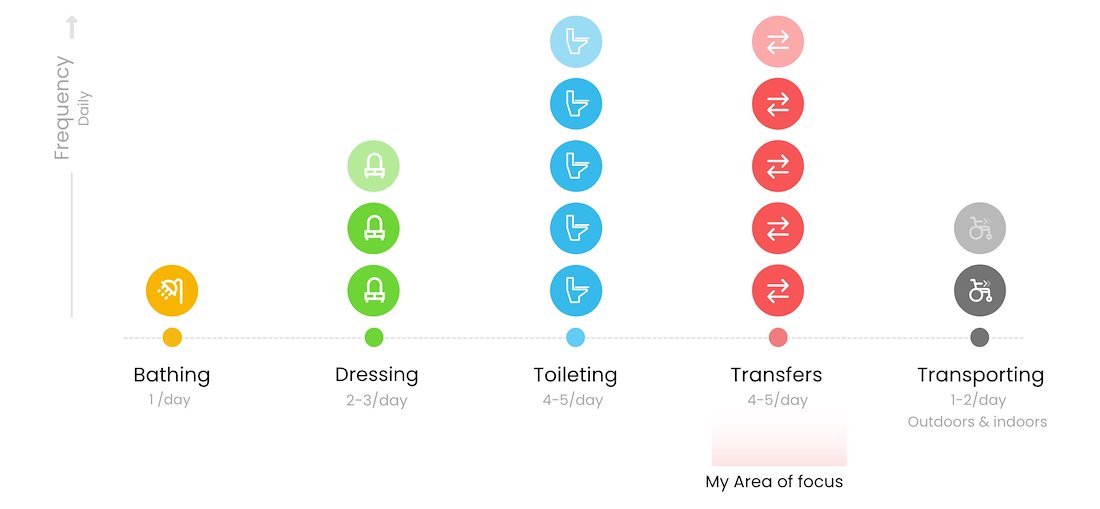
MY AREA TO FOCUS?
The focus area for me is transferring paralysed people at home from bed to wheelchair & vice versa, which affects the mental & physical well being of the caregivers. Let's see the transferring scenario with the problems faced by caregivers below in the diagram.
DID YOU KNOW?
82% caregivers are family members itself
35% cases, take advices from unqualified practitioners
Initial Design Brief
To design a system for assistance for a caregiver of a dependant/paralysed.
IDEATIONS
Concept 1 – UniBED
An integrated chair in your bed which can be moved and used as a wheelchair at home, so transfers can be eradicated mostly. Create a quick mockup to explain the concept.
USP : No transfer, easy transition & reduces an additional equipment.
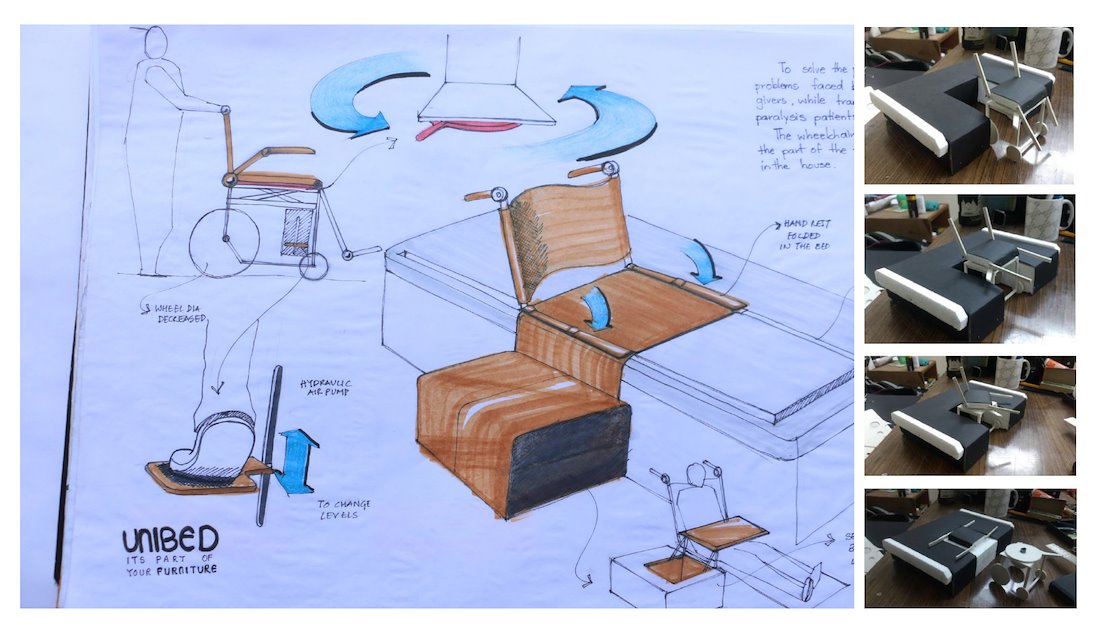
Concept 2 – Glove Design for Bed bathing
A caregiver bed bath's the paralysed member daily. So this concept is a glove design with the feature of wet cleaning & dry cleaning of the person, by putting soap water and normal water in the capsule above. Sponge is placed to eject soap water and normal water whenever required. After wet cleaning, replace the outlet with a blower module to dry the body.
USP : Easy usage, ergonomic design & reduces the usage of too many products.
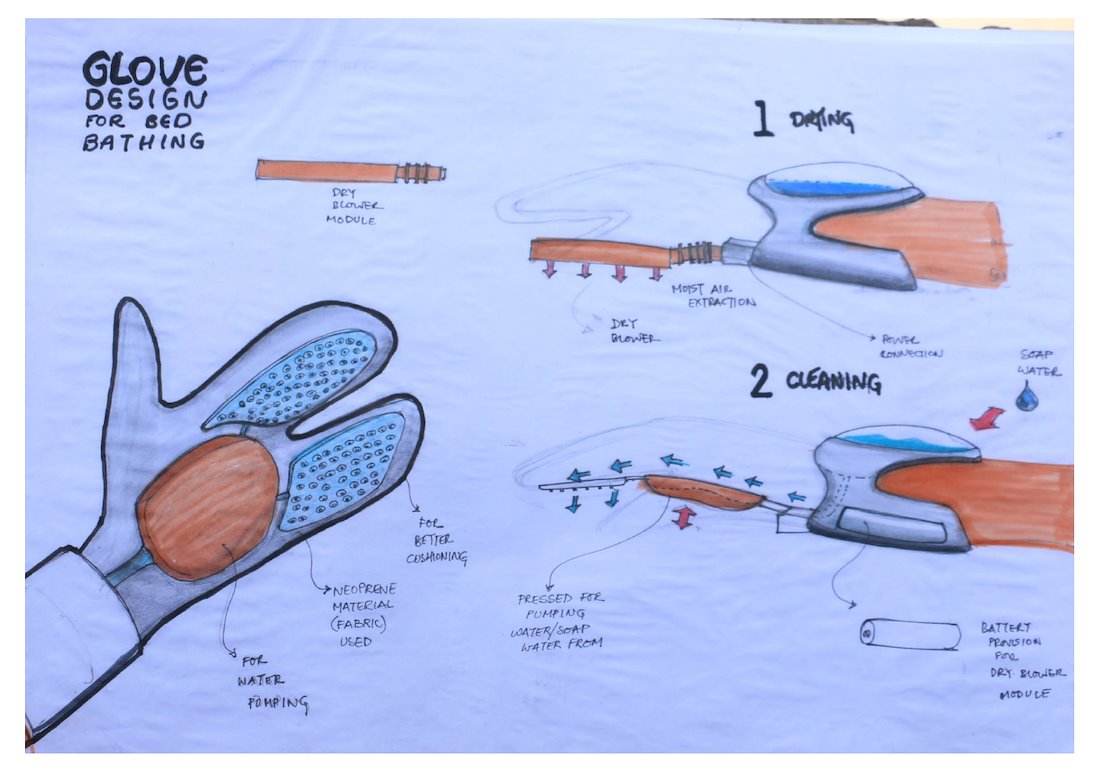
Concept 3 – Assistive aid to transfer
Option 1
A sturdy designed assistive aid equipment, can be used to lift patients from wheelchair & transfer to the bed vice versa. Check the step by step process below in the image.
USP : Light weight product, easy manufacturing & no need to replace large equipments.
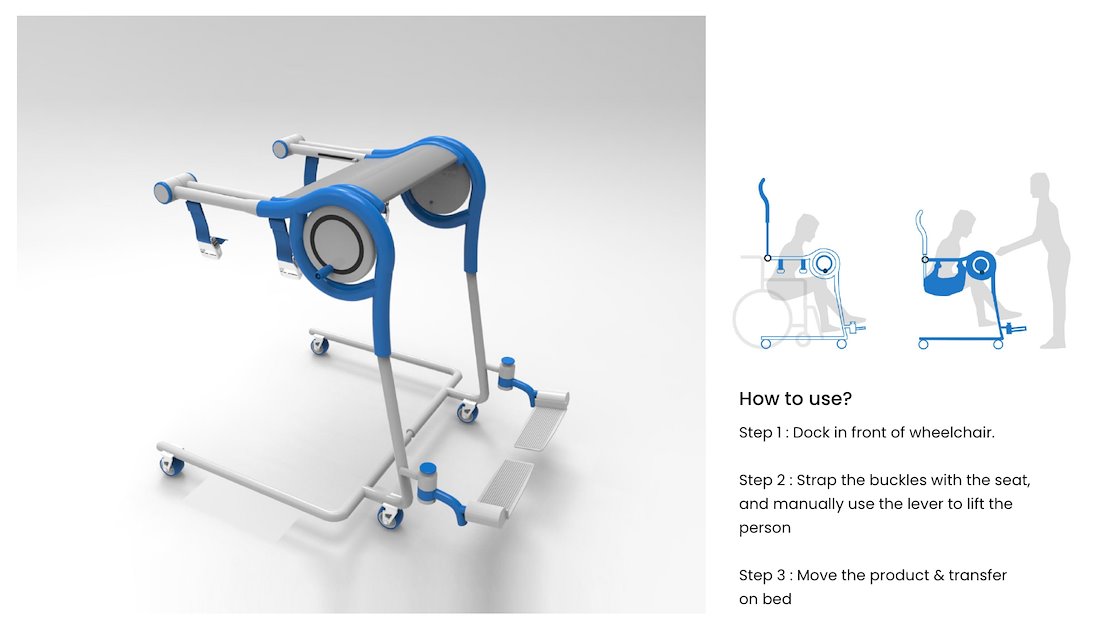
Concept 4 – Assistive aid to transfer
Option 2
Another option I explored in assistive aid product category, where the caregiver can use his/her counter weight and lift the patient and transfer them to the bed.
USP : Light weight & less space consumption.
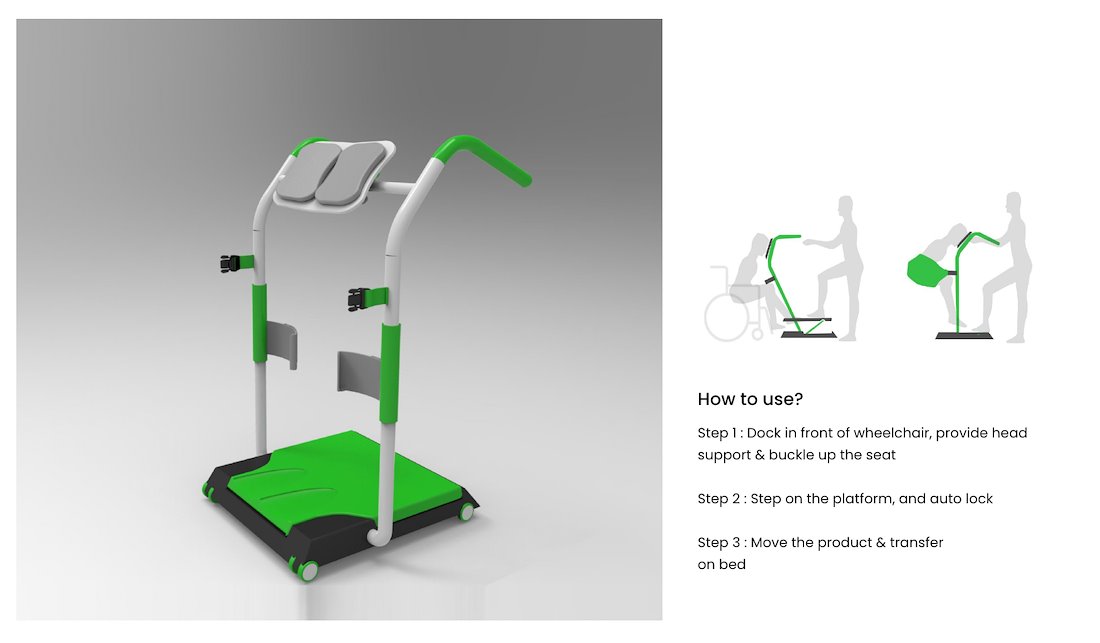
Concept 5 – Slide with ease
This concept is a wheelchair seat & bed redesign to slide paralysed person from wheelchair to bed, with the reference of fulcrum concept. Here lateral transfer can be down with roller mechanism. The stopper and rail is modified in the bed, so that it works with this concept.
USP : Light weight & less space consumption.

Concept 6 – Dekhbhaal
A social app for caregivers
Dekhbhaal is an app design concept, for caregivers to get in touch with nearby experienced caregivers of similar cases, to get initial guidance and know about caregiving as a whole. As caregivers cut off their social life at this point of time, this can be a support system for them to be motivated & keep going positively.
When most of the time, caregivers are finding difficulty to get in touch with experienced and professional people, this solution can promote and provide peer to peer learning experience.
USP : Peer to peer learning, socialising & awarness.

FEEDBACK FROM USERS
on the concepts
Would not prefer an additional product as the assistive aid concepts
Would prefer any redesign of existing products, so that they can replace it
As money is not a matter for them, as they can buy or rent it most of the times
Preferred & voted for the 1st concept of redesigning any of the 2 products, WC or bed
Preferred the bathing glove concept, as it was easy to do bed bathing
Some wanted to know the different products for specific cases. Can add Dekhbhaal app
Redefined Design Brief
To design a system (bed or WC), with which a caregiver can transfer paralysed person from bed to wheelchair & vice versa.
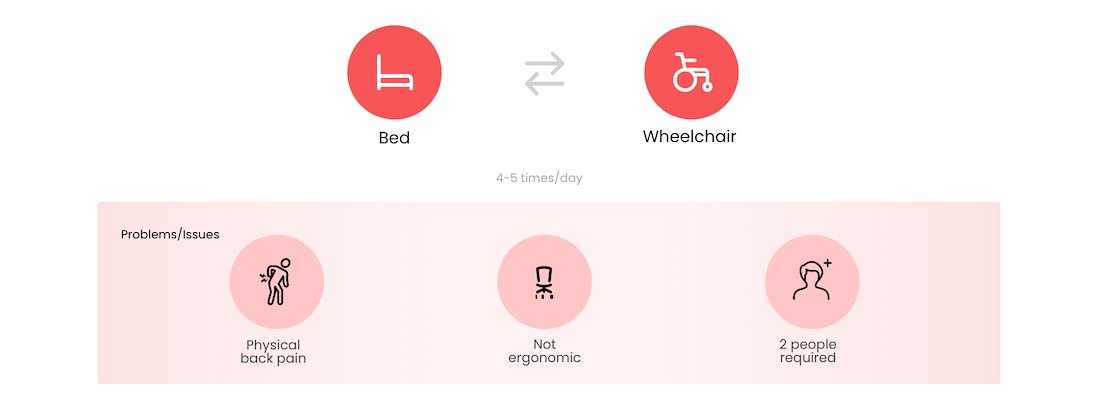
EMPATHIZE
Trying it out!
I tried out first to understand the points of pain while transferring fully paralysed person from wheelchair to bed. The manual process has a painful experience. Empathising was crucial for me to realise and get closer to the strong validation of this valuable area to work in.

EXISTING WHEELCHAIR STUDY
For better studying the dimensions, ergonomics & functionality, spent more time with a manual wheelchair which I had rented for this project. Well, this became my study chair for 3 months of the project.

Final Design
CONCEPT DEVELOPMENT
I started focusing on redesigning the wheelchair which solves the problem of transferring paralysed people laterally on beds and vice versa. So initially started concepts with integrating stretchers in wheelchairs and studying about them in detail.
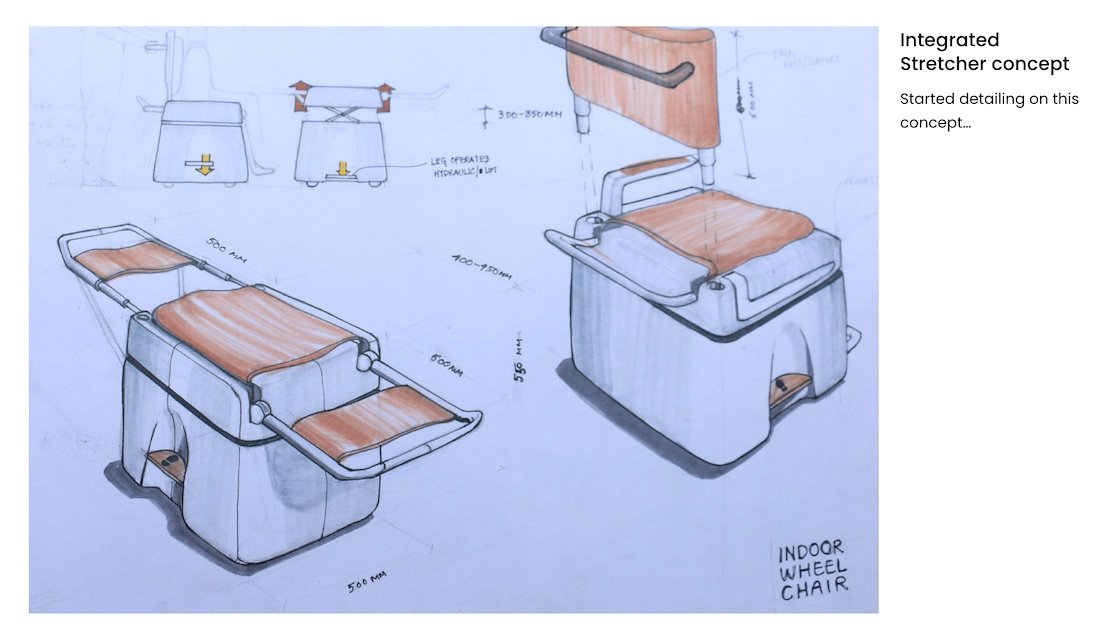
ONE THING I KEPT IN MIND
From my interviews with caregivers, paralysed people do not like to be treated as disabled or special people other than any other normal family member. So, I kept in mind to design an indoor wheelchair which should not look like a conventional wheelchair. It should be like any other furniture or chair in the home, which other family members use. They should not feel as if they are a burden to them or anything different than others.
FINAL DESIGN
A wheelchair design, with a scoop stretcher integrated like a seating, which folds & slides on a rail to transfer paralysed people from wheelchair to bed & vice versa.
Users : Caregivers & Paralysed person

HOW IT WORKS?
See the step by step process below of how it works exactly.
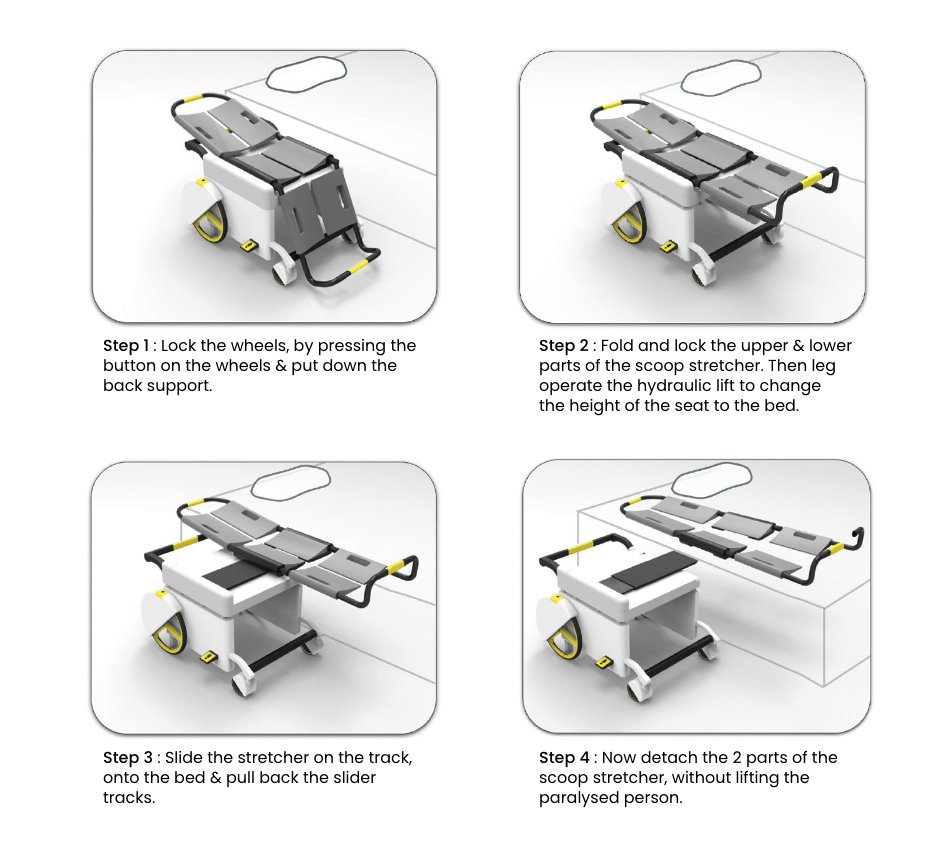
PRODUCT DETAILS
Here are some of the detail features which are included in the product for ease of usage.

Proof of Concept(POC) & Model making
Have a look below where I did a 1 : 1 scale of a model to explain my concept, by using drawer sliders as a track, to slide the stretcher.

FINAL MODEL
Due to the limited time of the project, I made a 1 : 3 ratio product model, as I had done a
1 : 1 model as POC already. Have a look at the Final model below.

RECOGNITIONS FOR THIS PROJECT
1. Runner-up for A' Design Award in Differently Abled and Seniors' Assistance Design Category, 2017 – 2018. Have a look here.
2. Winner for ADI International Student Design Competition in Industrial Design Category – 2018. Have a look here.

CONCLUSION
Will be soon sharing the Dekhbhaal – A guidance app for caregivers, which was also designed to help caregivers socialise and learn about caregiving in the journey.
You are not alone caregivers. We are all with you!
Thank you all for giving your time.
Do get in touch if you want to know more about the project.